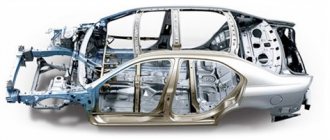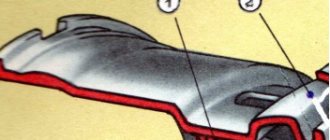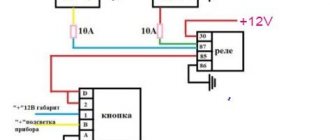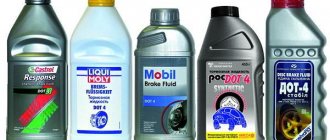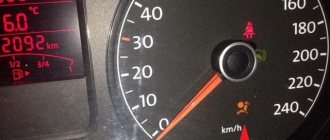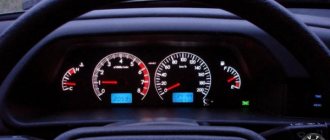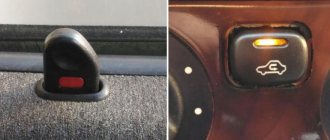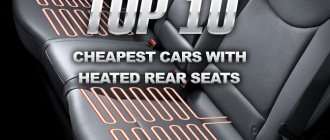Purpose and design
A vehicle's suspension performs several functions. Basic:
- ensuring elastic fastening of the wheel to the body
- vibration damping
- ensuring contact between the wheel and the road surface
It was invented at the same time as cars. She is as old as the first car released from production. At the same time, it has still not been possible to create an optimal suspension that would suit any car.
Despite the varieties, the products are similar to each other in their components. The design contains:
- Elastic elements - leaf springs, springs, etc. Their main task is to absorb the loads received when the wheel hits the chassis.
- Damping elements or shock absorbers. They dampen vibrations received from elastic elements through absorption and dissipation of vibration waves. That’s why they are usually installed next to elastic elements.
- Guiding systems. Designed to connect the wheel with the supporting part, which ensures the ability of the machine to move along the desired trajectory. This group includes levers, rods, beams.
All components perform a number of specific functions, and even without one element it does not constitute a single structure.
Suspension device
The suspension on different car models has different designs. However, the elements of which it consists can be divided into several groups depending on their purpose. They will be found on almost every vehicle model. These are the groups.
- Elastic elements. Includes springs, springs, torsion bars. The main task of these parts of the structure is to absorb part of the energy received from the road surface onto themselves, and distribute the rest of the energy that could not be absorbed evenly throughout the vehicle body.
- Extinguishing devices. They are units that use hydraulics or pneumatics to absorb shocks coming from the road surface. They can also be combined (in this case they are called hydropneumatic).
- Guide elements. These include levers, rods, beams, travel limiters, and steering knuckles. The main task of these components and parts is to ensure the correct direction of the wheel during straight movement or turns, thanks to which the best shock absorption and correct distribution of the load over other suspension elements will be ensured.
- Additional elements. These include various small metal parts that hold together the remaining structural elements. In addition, they include rubber gaskets, the main purpose of which is to reduce noise and vibration while the vehicle is moving.
- Anti-roll bar. A device that is designed to level the movement of a car when turning. Facilitates control and prevents sudden drifts.
Dependent suspension
The very first suspension produced and used on cars. It is she who is considered the longest-liver among existing structures. And the prototype for creation was a horse-drawn carriage.
A special feature is the reliable connection of the wheels, preventing the parts from moving relative to each other. The rear axle acts as the connecting axis. Elastic elements are springs, although not so long ago they were springs. The damping element is a shock absorber. Install it in two ways:
- Separate from the springs.
- On the same axis as them. This arrangement requires installation inside the spring.
The shock absorber is mounted from above to the body, from below - to the bridge. The shock absorber has two functions - one involves damping vibrations, the second - secures the wheels to the axle.
Levers and rods, located in the transverse and longitudinal directions respectively, are the components of the guide system. There are four of them in total. They make sure that the movement of the axle and wheels is predictable. The transverse link serves to reduce the roll angle when the car turns while it is moving. Pros:
- simple execution;
- reliability;
- ensuring high-quality grip.
The main disadvantage is the loss of traction between the wheels and the road if the car enters a turn. This can be very dangerous. Today they are not in demand, and they try not to use them. Mainly found on trucks.
List of types of passenger car suspensions
This article discusses only the main types of car suspensions, while there are actually many more types and subtypes of them and, moreover, engineers are constantly developing new models and refining old ones. For convenience, here is a list of the most common ones. Subsequently, each of the pendants will be considered in more detail.
- Dependent suspensions On a transverse spring
- On longitudinal springs
- With guide arms
- With thrust pipe or drawbar
- "De Dion"
- Torsion-lever (with linked or coupled levers)
- With swing axles
- Spring
- Active suspensions
- Air suspension
Independent
The difference between this suspension and others, as you might guess, is the lack of connection between the wheels, which are on the same axis and located parallel to each other. This way, if for some reason the position of one wheel changes, it will not be reflected in the other.
They are divided into several types, and each of them deserves special attention.
Main types of car suspensions
Here it should immediately be noted that the existing types of suspensions used on a wide variety of vehicles can be classified according to several criteria, but for modern passenger cars the division into dependent and independent is generally accepted.
Dependent suspension
It implies a rigid connection between the wheels. Historically, this was the first type of suspension created. In fact, it was not far removed from the design of carts, when two wheels were connected to each other by an axle. What such a pendant looks like is clear from the picture.
In this case, it is clear that the position of one wheel affects the other. So, when the right wheel hits an obstacle, the position of the left one changes, it tilts to the left, while the wheel is located at an angle to the surface, which somewhat reduces the grip patch with the road. This type of suspension was typical for cars at the dawn of their development. Now, if used, it is usually as a rear axle and on off-road vehicles.
Such suspension is usually leaf spring or spring. The first of those mentioned as an elastic element uses a spring, which is attached to the bridge beam, and its ends to the frame or body of the car. Another type of dependent suspension is spring suspension, in which a spring serves as an elastic element. What the spring (1) and spring (2) suspensions look like can be clearly seen in the figures below.
Despite the fact that dependent suspension was invented a long time ago and is considered obsolete, it is still used today, primarily on trucks and, as already mentioned, on SUVs. Its undoubted advantage is its simplicity of design and reliability, this is especially true for jeeps. Both spring and spring suspensions for any car provide:
- constant ground clearance, and this is a huge plus in off-road conditions and serves as an additional factor in increasing cross-country ability;
- constant track width;
- greater articulation. Articulation refers to the movement of the front wheel relative to the rear, at which the rear wheel completely loses contact with the road (see photo below). The later this happens, i.e. the greater this distance (articulation), the better it is when driving on a bad road;
- reliability, resistance to damage;
- low cost of operation;
- the ability to carry out effective off-road tuning.
From the above advantages of a dependent suspension, whether it is spring or spring, the clear conclusion is that it works great off-road. However, the overall picture becomes not so blissful when the off-road ends and the car begins to move on the asphalt. In this case, those types of shortcomings that were indifferent on a bad road become obvious:
- not the best handling due to significant sprung masses at high speeds;
- poor directional stability;
- insufficient comfort for passenger cars.
Independent suspension
This is a completely different version of the suspension, which has nothing in common with the dependent one already discussed. With this design, there is no rigid connection between the wheels. How schematically this looks can be understood from the figure below. In fact, such a suspension means that the wheel (each) is attached to the car body separately and when one wheel oscillates, these changes are not transmitted to the other, due to which body roll is reduced and stability is increased. There are many options for how to do this, but all of them can be divided into main types: lever and candle. The latter include MacPherson suspensions, the former:
- double lever;
- wishbone;
- helical lever;
- longitudinal lever.
The most common are MacPherson and wishbone suspensions. The reason for this is the advantages they provide for passenger cars:
- good handling;
- good feedback when steering;
- high level of comfort;
- small rolls;
- high speed.
Combined suspension
It is a combination of the two pendants already described. The car has an independent suspension at the front and a dependent axle at the rear. It is to some extent a compromise, allowing you to move quite comfortably on asphalt, but at the same time overcome minor off-road conditions without any particular difficulties.
This combination is well suited for crossovers and SUVs, providing the ability to move freely around the city and go into the forest for a picnic or drive a little along country roads. In terms of their capabilities, the result is something average, but for the majority they provide acceptable driving conditions.
MacPherson struts
Many people know this type as a “swinging candle.” The main difference is the presence of a shock-absorbing strut, which performs several functions at once. In this case, all functions are performed simultaneously. The design involves:
- shock absorber;
- spring.
The element is attached to the wheel hub from below, and to the body from above. In the second case, additional supports are also used. Thanks to this type of fastening, it is possible to ensure reliable fixation of the wheel with the body when rocking. There is also a guiding system. Its role is played by levers having a transverse direction.
The stand is the most popular and in demand type. Its purpose is to ensure comfortable movement on the road. The suspension is valued for its reliability and durability.
Lever
The lever type is also a representative of an independent type of suspension. A fairly well-known option, which has two types of design:
- Double lever. The shock absorber strut is used only to dampen vibrations. Fastening is carried out by a control system, which includes two transverse arms with an A-shaped design. The part prevents unnecessary movement of the wheel when driving. However, in comparison, the MacPherson strut is softer and easier to control.
- Multi-link. Improved double-lever design. Two levers are complemented by eight more similar parts. Due to this, it was possible to improve the smoothness and comfortable driving.
Basically, preference is given to MacPherson struts and a double-lever design. They are found in most vehicles and are especially popular among modern and expensive models. Also preferable for installation in cars with soft suspensions.
Torsion bar suspension
In modern cars, a type of suspension called a torsion bar suspension is quite common. This type of pendant combines the qualities of the two types of pendants described above. The torsion bar in a torsion bar suspension plays the role of an elastic element. It is attached to the frame at one end, and at the other end it is attached to the moving element. The design provides space for a beam that operates under pressure. The torsion bar can be made with a round or square cross-section. This type of suspension is compact and convenient for use on small cars.
Useful: Handbrake: why is it needed, features
MacPherson strut is another type of common suspension, this type of car rear suspension is widely used in the automobile industry. Such a suspension can be created for the front and rear wheels. There is a large distance between the support units in such a suspension, which is a significant advantage. This suspension design is more suitable for smooth roads. On bumps with MacPherson suspension, shocks are strongly felt. Also, all types of suspensions are divided into single-lever and multi-lever.
Semi-dependent
This type of pendants is something in between the options described above. In appearance, the design resembles a dependent suspension. It also has a beam and trailing arms, thanks to which it is possible to connect two wheels located on the same axis.
The semi-independent suspension is secured using levers. Elastic and damping elements are the familiar springs and shock absorbers, respectively.
But the semi-independent beam is torsion bar, which allows it to also work in torsion. Thus, the wheels can move in a vertical direction independently of each other.
Pros:
- simplicity;
- reliability.
Often found on rear-wheel drive cars.
Car rear suspension device
The vast majority of cars today are equipped with multi-link independent rear suspension. The rear wheels in this configuration are independent of each other. This made it possible to reduce the risk of lateral skidding and generally increase the stability of the car.
The rear suspension consists of the following parts:
- trailing arms of each wheel;
- wishbones (2 for each hub);
- anti-roll bar;
- stabilizer supports;
- shock absorber
Most often, suspension repair means replacing shock absorbers. The operation must be performed in pairs, that is, on the left and right wheels at once. This requirement is due to the fact that during manipulations the center of gravity of the body cannot be allowed to shift. When replacing only one shock absorber, the body may skew to one side, which will entail a shift in the vehicle's center of gravity. The rear axle of a car usually experiences less load while driving than the front axle. Therefore, the rear suspension shock absorbers are changed less frequently than the front ones.
There are three main types of car rear suspension designs. The suspension can be based on springs, springs with shock absorbers, or an air shock absorber.
After replacing the rear shock absorbers, the air suspension must be adjusted. This cannot be done in a garage; special equipment is required.
The second most common type of suspension repair is replacing stabilizer bushings.
The stabilizer coordinates the operation of the rear wheel levers. In addition, thanks to the stabilizer, the car is more stable when driving on uneven roads. You can change the stabilizer struts of the rear arms yourself; no special tools or much experience are required. The work will take 1-2 hours, provided that the support nuts have not soured. If they are rusty, it will take some more time to unscrew them.
The levers are attached to the body and hub using silent blocks. These are metal bushings with a rubber or polyurethane gasket. Thanks to this layer, suspension shocks are compensated. However, road conditions - moisture, reagents, temperature fluctuations - have a destructive effect on silent blocks. After some time of operation, silent blocks can no longer cope with shock compensation.
The work of replacing a silent block is quite labor-intensive and difficult for an unqualified mechanic. Therefore, it is better to leave this operation to professionals.
What happens if you use faulty silent blocks? Worn bushings can cause a number of defects, including violation of wheel alignment angles, uneven tire wear and deterioration of vehicle handling. Ignoring the malfunction for a long time will lead to wear in the levers. If the situation escalates to such a phenomenon, then you will have to change the entire rear lever assembly.
We recommend
“Diagnostics of car suspension on a vibration stand: trust, but verify!” More details
Hydraulic
Hydraulic suspension has a number of features. The main one is the modified shock absorbers. Unlike standard shock absorbers, conical shaped parts filled with oil are used. Additionally, each part is equipped with a spherical hydraulic accumulator.
Among the advantages:
- durability;
- smooth ride under all conditions;
- possibility of adjusting the ride height remotely.
They are strong and quite reliable. However, the downside is the presence of oil in the design. The fact is that if an oil leak occurs, not only the product will fail, but also the brake system and power steering.
Simplicity and rigidity of the rear suspension.
The rear suspension of front-wheel drive foreign cars has recently become increasingly dependent, with a torsion beam. This decision is, again, due to the forced reduction in the cost of cars and a reduction in manufacturer costs. The rear wheels are rigidly connected to each other by a torsion beam, which works by “twisting and unwinding”. Comfort and controllability, of course, are reduced, but this, again, manifests itself to a greater extent on bad roads.
This suspension is inexpensive to maintain, however, as a rule, its travel is very small, which causes a feeling of a “goat’s butt” on potholes. On cargo-passenger versions of cars, springs are often found instead of springs (for example, on the Toyota Caldina), although shock absorbers are also common (on the Nissan Expert). Since shock absorbers work from full extension to the bump stop, they wear out quite quickly and also require careful attention. When loading the rear of the car, this suspension is softer.
I wish I had one like that! Multi-link suspension is used on mid- and high-class cars with various drive formulas. “Multi-link” is found both front and rear. In such a suspension, at least four levers are used to attach the wheel hub. This solution ensures independent longitudinal and transverse wheel adjustment and stable camber angles.
In modern designs of multi-link suspensions, along with transverse levers, longitudinal ones are used. The suspension is expensive to manufacture and install, which limits its use on assembly lines of mass-produced and inexpensive car models. But the “multi-link” has the advantage of high smoothness, low noise level, better controllability, and lower wear rates of elements. There are a great many options for solving a multi-link suspension, unlike previous schemes.
Our experts are unanimous in their opinion: in order for any type of suspension to not let the car owner down, it needs an eye and an eye.
There are no elements in it, the failure of which would not provoke rapid degradation of other components.
“Our roads deal with suspension elements quite quickly, sparing neither “our own” (domestic cars) nor “others” (foreign cars). Car owners should be clearly aware that a faulty suspension is not just a reduction in comfort, but also a mortal danger. A barely noticeable play in the steering tip means extra meters of delay in the car’s reaction during a sharp maneuver, especially at high speed.
A “dead” strut can result in falling into a ditch when hitting an obstacle. Faulty rear shock absorbers cause body movement, and your butt (that is, the rear of your car) will sooner or later end up in oncoming traffic when you brake hard. The suspension begins to “die” from the struts, then increased forces are applied to the supports, silent blocks, and levers.
It is very important to check the condition of the undercarriage at least twice a year. Our winter has a very bad effect on tires and shock absorbers, and metal becomes brittle in such cold weather. A high demand for suspension maintenance is usually observed in spring and autumn, although it is better to eliminate problems during the dry period, when there is not much water on the streets penetrating into all the cracks of the chassis components.
Restoring suspension components such as ball joints, struts and shock absorbers is well worth the effort. After all, 90–95% of the Japanese shock absorber does not wear out, which means it can continue to be successfully used. The same goes for ball joints. With high-quality restoration, the product receives a new resource, sometimes exceeding the original one - factory. Moreover, the unit becomes adapted to our operating conditions. But there are exceptions - monotube shock absorbers are practically not subject to restoration.”
Screw
Helical suspension is a general name for several types of suspensions, the design of which provides the ability to regulate the degree of spring pretension. The advantages of this design are:
- ease of maintenance;
- strength;
- durability;
- good job for Russia.
She is tough and almost indestructible. If it breaks, you can fix it yourself. At the same time, manufacturers recommend inspecting the structure as often as possible. To avoid frequent breakdowns, you can lubricate the surface of screw-shaped shock absorbers with a special lubricant.
